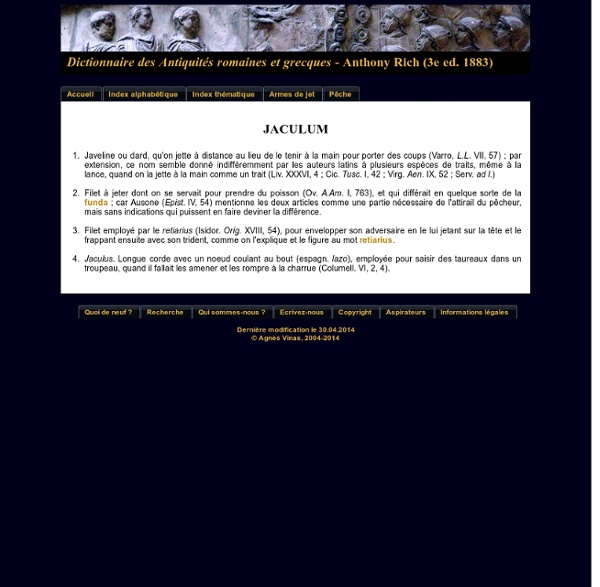



Hasta Lance, employée comme une pique pour percer, et comme un trait pour être jetée avec la main. Elle se composait de trois parties distinctes : la tête (cuspis, αἰχμή et ἐπιδορατίς) en bronze ou en fer ; le bois (hastile, δόρυ) en frêne ou autre bois ; et une pointe de métal au bout (spiculum, σαυρωτήρ ou στύραξ), qui servait pour la fixer verticalement dans le sol, ou qui devenait une arme offensive quand la tête était brisée (Polyb. VI, 25). A Dictionary of Greek and Roman Antiquities (1890), HASTA and bottom of a spear, which is held by one of the king's guards in the sculptures at Persepolis. (Sir. R. K. Porter's Travels, vol. i. p. 601.) A well-finished spear was kept in a case (δορατοθήκη), which, on account of its form, is called by Homer a pipe (σύριγξ, Il. 19.387). The amentum added to the effect of throwing the lance by giving it rotation, and hence a greater degree of steadiness and directness in its [p. 1.936]flight, as in the case of a ball shot from a rifle. to the insertion of the fingers, and accounts for the frequent use of the verb torquere, “to whirl or twist,” in connexion with this subject. Under the general terms hasta and ἔγχος were included various kinds of missiles, of which the principal were as follows:-- Whilst the heavy-armed Roman soldiers bore the long lance and the thick and ponderous javelin, the light-armed used smaller missiles, which, though of different kinds, were included under the general term hastae velitares (Liv. 26.4, 38.20; Plin.
Roman Weapons The Gladius The gladius, or Hispanic Sword as they called it, is the iconic short sword of the Roman army. It was adopted from the clans and tribes that lived in Spain. These tribes of Iberians, Celts and a large mixed group called Celtiberians, created hill forts and cities. Tribes of these three groups frequently warred with each other, developing an effective style of warfare but remaining politically divided. In combat the gladius could be used for stabbing or slashing, although it was primarily used for stabbing. The gladius served the Romans as the main Roman weapon through the rest of the Roman Republic and partially through the Empire (4th century BC - 3rd century AD). The Pilum The pilum is the heavy javelin used by the Roman legionnaires. In the Battle of Pydna (168 BC) between Rome and the Macedonian Antigonid dynasty, the Romans although a first awed by the power of the phalanx, were able to smash it.
Pilum ("Roman" spear) Project For plumbata, the basic parts are a point, a shaft, fletchings, and a weight. The point could be a 6- to 8-inch piece of 3/8" steel rod, with one end forged into a leaf shape. For the shaft, I'm thinking of a 16-inch piece of 1/2" to 5/8" wooden dowel, with 3/4" being the widest I'd accept. For flights, I'm thinking either feathers or leather, or even thin wood. As an alternate construction method, I could use 1/2" round stock and a 1/2" shaft, with the butt of the head and the head of the shaft inserted into a piece of plumbing pipe. In either case, the Dirty Bob version of the plumbata would look like a lawn dart from Hades, with some of the shaft extending behind the flights as a handle. Ya, wanna know, why, though, I really made the pilum in the first place? If several people each had a "plant stake" or two, they could be quite a formidable group to reckon with, especially if guns were scarce. Sorry for going on so long, but that's what I was thinking about while I made that spear!
Pilum Un article de Wikipédia, l'encyclopédie libre. Ne doit pas être confondu avec la hasta (« lance ») dans l'armement romain Le pilum est un modèle de javelot lourd utilisé par les légions romaines. En latin, le pluriel est pila, mais en français le pluriel peut s'écrire pilums. Description technique[modifier | modifier le code] Reconstitution de pilum lourd Il semble que dans un premier temps seuls les triarii, vétérans de la troisième ligne de la légion, en furent équipés, car ils étaient également appelés pilani. Végèce qui écrit au Ve siècle décrit ainsi l'arme de jet des anciens soldats romains : « Au nombre des traits en usage dans l'infanterie, le javelot (comprendre pilum) consistait en une pointe de fer triangulaire, de neuf pouces ou d'un pied, adaptée à une hampe ; enfoncé dans le bouclier, il ne pouvait en être arraché ; dirigé avec intelligence et vigueur contre la cuirasse, il la pénétrait aisément[4]. » Lancement du pilum[modifier | modifier le code] Pointe de pilum courbée